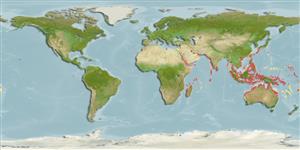>
Gobiiformes (Gobies) >
Gobiidae (Gobies) > Gobiinae
Etymology: Favonigobius: Latin, favonius = gentle, propicious and Latin, favonianus = the west wind; 1656 + Latin, gobius = gudgeon (Ref. 45335).
More on author: Fowler.
Environment: milieu / climate zone / rango de profundidad / distribution range
Ecología
marino; salobre demersal; rango de profundidad 0 - 5 m (Ref. 11441). Subtropical
Indo-West Pacific (Ref. 2798) and the Mediterranean Sea (Ref. 80021).
Tamaño / Peso / Age
Madurez: Lm ? range ? - ? cm
Max length : 8.3 cm TL macho / no sexado; (Ref. 11344)
Short description
Claves de identificación | Morfología | Morfometría
Espinas dorsales (total) : 7; Radios blandos dorsales (total) : 8 - 9; Espinas anales: 1; Radios blandos anales: 8 - 9. Body with small spots; sides with 4-5 groups of black spots, last spot on caudal peduncle often paired and ending with a thin vertical bar at caudal fin base (Ref. 2798). Males with 6-8 dark vertical lines on belly; dorsal, anal and pelvic fins dusky to black; caudal fin with thin wavy bars and upper margin with 1-2 black spots (Ref. 2798). Females with spotted fins except for pelvic fins (Ref. 2798); characterized further by having pelvic fins united medially; presence of pelvic frenum; rounded caudal fin; longitudinal scale series 27-28; ctenoid scales except cycloid on breast and base of pectoral fin base; predorsal scales 1-2, no scales on remainder of head; depth of body 5.8-6.2 in SL (Ref. 90102).
Body shape (shape guide): fusiform / normal.
Facultative air-breathing in the genus (Ref. 126274); Inhabits silty sand bottoms and seagrass areas (Ref. 11441).
Life cycle and mating behavior
Madurez | Reproducción | Puesta | Huevos | Fecundidad | Larva
Heemstra, P.C., 1995. Additions and corrections for the 1995 impression. p. v-xv. In M.M. Smith and P.C. Heemstra (eds.) Revised Edition of Smiths' Sea Fishes. Springer-Verlag, Berlin. (Ref. 11228)
IUCN Red List Status (Ref. 130435: Version 2025-1)
Threat to humans
Harmless
Human uses
Herramientas
Special reports
Download XML
Fuentes de Internet
Estimates based on models
Preferred temperature (Referencia
123201): 24.7 - 29.3, mean 28.5 °C (based on 2911 cells).
Phylogenetic diversity index (Referencia
82804): PD
50 = 0.5020 [Uniqueness, from 0.5 = low to 2.0 = high].
Bayesian length-weight: a=0.01023 (0.00477 - 0.02194), b=3.01 (2.83 - 3.19), in cm total length, based on LWR estimates for this (Sub)family-body shape (Ref.
93245).
Nivel trófico (Referencia
69278): 3.5 ±0.4 se; based on size and trophs of closest relatives
Resiliencia (Referencia
120179): Alto, población duplicada en un tiempo mínimo inferior a 15 meses (Preliminary K or Fecundity.).
Fishing Vulnerability (Ref.
59153): Low vulnerability (10 of 100).
🛈
